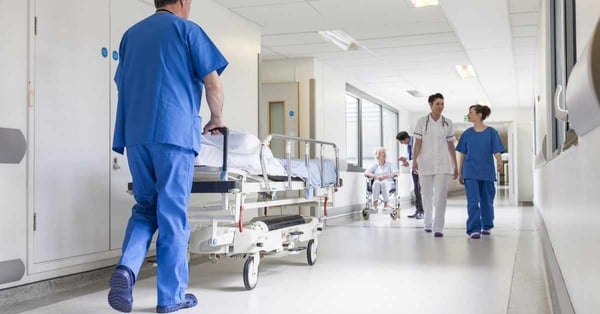- Blog Overview
- Knowledge
- How the Patient Experience in Hospitals Can Influence Better Overall Health Outcomes

How the Patient Experience in Hospitals Can Influence Better Overall Health Outcomes
Eric Rutherfurd |April 6 2023 | 7 min
Not wanting to hang around a hospital is universal. Patients are nervous, scared, and likely in pain. It certainly can make for an uncomfortable and unhealthy situation.
However, by creating a more thoughtful and deliberate patient flow, you can create a better patient experience and put your patients more at ease. The patient flow should showcase the professionalism of the hospital and connect the patient to an elevated experience. With proper patient flow management systems in place, today’s healthcare facility can create better efficiencies, bolster its reputation, and improve its operational processes, all while achieving better overall health outcomes for patients.
The Case for a Better Patient Experience
The arguments for why hospitals should invest more in improving patient experience are many, but with tight budgets and limited resources, it’s crucial to pinpoint how it can help enhance overall patient health outcomes and staff satisfaction. Fortunately, plenty of evidence showcases the value of improving the patient experience in hospitals when healthcare providers have embraced actively working with it.
- Lowers medical malpractice cases: For every drop in patient, reported scores that went from very good to very poor (on a five-step scale), the chances of a malpractice suit increased by 21,7%.
- Generates positive patient feedback: A positive patient experience results in the patient telling others, particularly on social media and review sites, and patients expressing more gratitude towards healthcare staff. Positive patient feedback is essential for your marketing outreach to potential patients, patient retention, and improving the work environment for staff.
- Creates patient loyalty: One report noted that a 10% increase in patient loyalty could generate more than $22 million in revenue for the average hospital. Furthermore, it increases hospitals’ patient retention, making it possible to establish good patient relationships.
- Reduces staff turnover and burnout: Efficiently managing patient flow also means internal resources are properly utilized, and resource allocation becomes easier and more accurate. So, a better patient experience ultimately creates a more enriched employee experience when the work environment is improved.
And the ultimate reason for any of this is that it can lead to better patient health outcomes. A happy patient is ultimately a healthier patient. Patients who are satisfied with the experience are more likely to follow medical advice long-term and actively participate in their healthcare plan.
Studies show that diabetic patients who have positive interactions with providers show greater self-management skills, and patients who had positive experiences when hospitalized for heart attacks had more positive outcomes a year after discharge. Patients and providers communicate better, which means patients work together with healthcare staff to get improved and optimized results.
A Check-Up Upon Check-In
The patient journey starts at the very beginning when patients reach out to the healthcare and doesn’t end until after the visit or treatment. So, what must be done to promote a more positive patient experience in hospitals throughout the patient journey? Map up all patient touchpoints and identify where the patient experience is perceived as positive and where it can be improved with new solutions.
To begin with, make the appointment scheduling process easy and convenient for patients since it’s one of the most universal pain points for them. Make your hospital easy to find, contact, and schedule appointments with different departments. Using an appointment scheduling system enables you to do all these things and is an easy solution that offers patients more control over their care journey online. No more frustrating back and forth between the patient’s and doctor's calendars to find matching availability for an appointment, which is both a time-consuming and tedious process.
The online appointment booking system allows the patient to list the purpose of the visit as well as coordinate several appointments simultaneously. Once an appointment is made, the patient is kept informed with reminders, check-in information, and location, everything they need to be on time for their appointment. The pre-arrival process is streamlined. Another plus to having patients use self-service options is reduced administrative workload for staff.
Upon arrival, a patient can check-in and wait anywhere, even off-premises, with mobile tickets. Scheduled appointments keep everything running more smoothly for both the patient and medical professionals, but if there is a wait time, the patient is alerted with specific information. The waiting experience becomes more pleasant with the patient involved throughout the process.
While non-emergency check-in is just one example of how patient flow can be made more efficient at hospitals, the same principles can be applied from pre-arrival through post-service. An elevated, comprehensive patient journey keeps both patient and medical personnel informed, involved, safe, and satisfied.
Happier and healthier patients
As the competition in the healthcare market increases and patients become more involved with their care, the quality of the patient experience in hospitals can directly impact health outcomes and the healthcare provider's bottom line. In the 2021 Accenture Health and Life Sciences Experience Survey, 67% reported a negative experience with a medical provider, pharmacy, or hospital. And the leading cause for that? “The visit was not efficient.”
And those negative experiences had far-reaching impacts on both patients and providers:
- 1/3 of respondents switched healthcare providers.
- And 1/3 were less likely to seek medical care next time they needed it.
So, what makes for a positive patient experience? Efficient, well-coordinated care, support, and communication. Taking a patient-centric approach to healthcare becomes a win-win for both patients and hospitals.
The best prescription for healthier, happier patients today is to focus on delivering a solid patient experience in hospitals.








